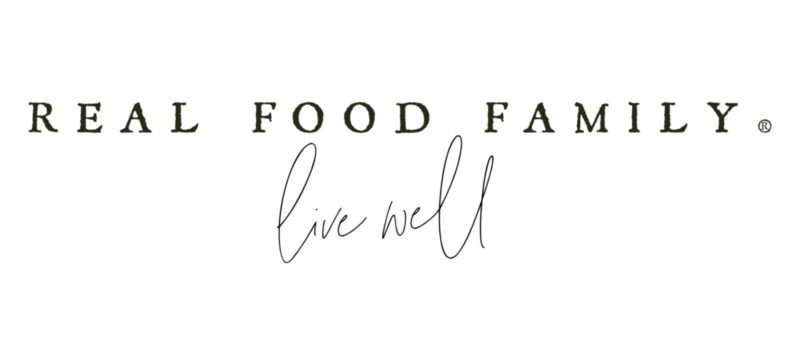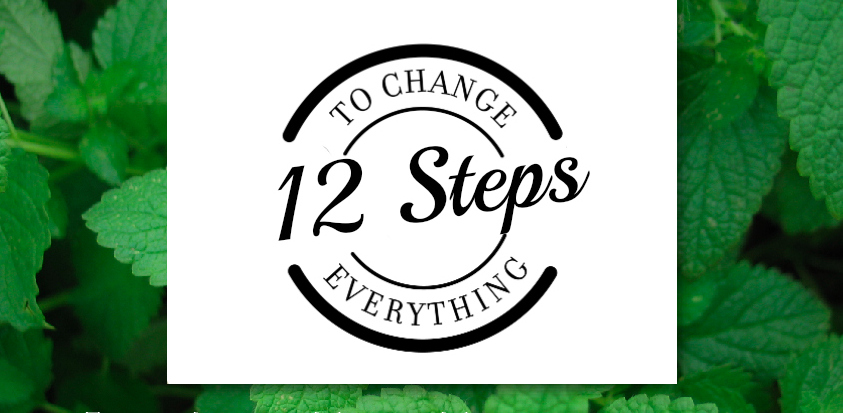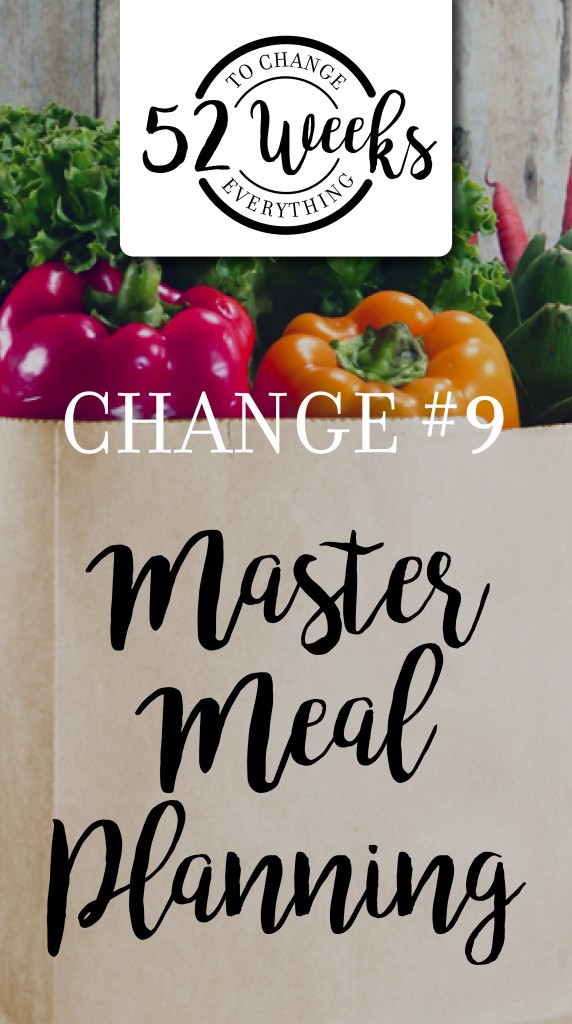Changes #2-#8 in our “12 Steps” series officially covered all the daily food requirements, in detail, from our Real Food Cheat Sheet printable.
Hopefully by now you understand our silly collection of words on the cheat sheet:
Violet Made Eloise Chew 5-Valuable Pickled Blue Feathers…
That’s our funny sentence that helps us remember to eat:
Vitamins, Milk, Eggs, Cultured foods, 5 Vegetables, Protein, Broth and Fat
Do you get it??
It’s strange, I know, but our family came up with it and it totally helps the kids remember all the things they should be eating every day, and it becomes more like a game.
Sometimes when I teach families this daily food requirement thing, panic starts to set in…
How in the world can I get my family to eat that stuff?
I can’t afford it!
I’m too busy to get all that in EVERY day!
The Answer Is: Master Meal Planning
I started meal planning after I got married in 2005. As the story goes, I wanted to impress my new husband with my cooking skills and planned every meal with care (and exerted effort). I spent hours every week filtering through cooking magazines and watching cooking shows in order to put together a weekly 3-meals-a-day plan. I usually adjusted recipes enough to make them my own. That’s how this whole website got started! I was a full-time Broadway performer and devoted new wife. My nutrition degrees and certifications came later, as well as the kids.
Nutritional convictions and my role as a mother, as well as fluctuation of our family budget, powerfully influenced the evolution of my meal planning skills. First came the beta version of my online meal plans (formerly called “The Reality Chef”). Then I wrote and published (and sold out of) a meal planning cookbook called “Real Food Family’s Complete Guide To REAL Food” (which will be available again as an ebook soon!). Next came version 2.0 of my online meal plans, called “Real Food Weekly“, which is available now as a meal plans library (with recipes and shopping lists in each printable pdf).
As I write this, our personal weekly meal planning runs as routinely as a family of five with a tight budget and an extremely active schedule allows. I’ve spent hours adjusting and updating our weekly meals outline and every ingredient needed for the shopping list. I’ve also spent hours researching at my favorite grocery stores, farm stands and discount stores to compare quality and prices of ingredients. Now I hope you can benefit from all the work I’ve done!
I’ve created a free printable meal planning outline for you!
Click here to download the free printable meal planning outline.
This outline does not have recipes, however it lists a week of meal options (breakfast, lunch, snack, and dinner) for our family. The shopping list is specific for weekly staples, with options for items that vary by week based on the meal you choose to make. Of course you can find recipes in the Real Food Family Recipe Library or at our actual meal plans library: Real Food Weekly!
Our meal plans work for our family’s nutritional goals, budget and active lifestyle. Every family has different convictions, of course, but below is a list of the criteria for our weekly meal plans and will likely work for most families committed to quality REAL food meals:
- We eat 3 meals per day with one afternoon snack for the kids (adults get a snack only if we are hungry, but it’s usually we enjoy a latte instead of food). We do NOT allow “grazing” all day long, as this, in our opinion, messes up blood sugar regulation and creates bad eating habits. You can read more why I care so much about this rule here.
- We try to include all the daily food requirements from our REAL Food Cheat Sheet.
- We eat REAL food, meaning all ingredients we eat occur in nature and are minimally or not processed at all. Shopping list ingredients are the best quality we can find and afford. We eat almost entirely organic plant foods and sustainably raised organic animal foods. We don’t have any special diet requirements or needs other than this kind of REAL food, so you’d have to make your own adjustments and substitutes if you know you have special needs.
- We make our food from scratch, with very few pre-made items like tortillas, pasta, yogurt, juice, high quality sprouted granola, peanut butter, jam, etc.. We try make those items ourselves whenever we can, usually on a weekend or free time set aside for food preparation. We NEVER buy convenience foods like flavored yogurts, salad dressings, frozen waffles, canned soup, etc., nor do we EVER buy processed or fast food. These “food” items are nutritionally inferior and too expensive when you know how to make things yourself.*This should not intimidate you, make you hate me for bragging, or make you think you should make perfectly organic and high maintenance recipes at every meal. It’s a matter of changing habits. Scrambled eggs with toast or grilled cheese sandwiches with cut vegetables and fruit on the side is a perfectly decent breakfast, lunch, snack, or dinner, and is often served in our house!
- We stay on budget.
More often than not, people reject eating REAL food and making meals themselves because they believe buying convenience foods and fast foods are less expensive. When you know what to look for and where to find it, healthier food is actually less expensive, or it is absolutely worth the price if it is more expensive. Let’s say you have a choice to let your kids play in a pool for $1 but that pool is full of algae, pee and poop. Or you can spend $3 to let them play in a clean, sanitary pool- free of pee, poop, and disease. I can’t imagine you’re going to choose the $1 pool and turn a blind eye. OR you might choose to forego the pool altogether and find something else to do for $1.What I’m trying to explain is if you MUST eat beef, for instance, choose the better quality beef and avoid eating animals raised in their own waste, or who live in cages they can’t turn around in, who are shot up with hormones and antibiotics (that are in the meat you’re eating), who are cruelly smashed until they are dead enough to go to the butcher. If you aren’t willing to pay more for the pasture-raised organic cow who was raised without the drugs and killed humanely, then go buy some organic beans instead. You always have choices and you get what you pay for. I’d love to have grass-fed rib-eye steak every week, but our budget only allows for ground beef or stew meat most weeks…mixed with plenty of organic beans. Again, you always have choices and you get what you pay for.I’ve spent hours reformulating our shopping list and researching grocery stores, farm stands and wholesale stores (including Thrive Market online) to fine-tune our meal plans to match a reasonable budget. We do NOT waste food and we try to go through as much of our food supply as possible before returning to buy more food. We are usually able to feed our family of five for $600-$850 per month if we are as responsible as possible. Of course this varies dramatically based on where you live and what food is easily available. I’ve asked my readers over the years to share their monthly food budgets based on organic and REAL food meal plans and their responses from all over North America and Europe range from $600 per month to $1300 per month for family of 4-6. I would LOVE to know how families who eat and cook all their meals like we do can get their monthly grocery bill below $500! By the way, we RARELY eat a meal at a restaurant, and if we do, it doesn’t come from our grocery budget but our monthly spending/entertainment budget. - We stay on schedule.
If it’s not budget that turns people away from eating and cooking REAL food, it’s convenience. Busy families believe cooking is not possible, at least not every day. I would argue that my family is pretty darn busy and we still eat proper food! We run two businesses from home (three if you include this website), we homeschool full time, the girls take 18+ hours of gymnastics and dance every week, we are active in our church’s weekly services and meetings, my husband and I go to the gym and workout at home frequently, and we usually spend at least one afternoon at horse stables or doing other outdoor hobbies every week. I’m not bragging, or complaining, but I’m pointing out that it takes commitment and good planning to make the whole cooking-your-meals-thing happen.It also takes motivation…WHY is it important to start buying and cooking your own food? Since the 1950’s, we as a “modern” people have been sold on the food industry’s claim that they can “make better food than you can make, and you don’t have to cook it“. The average daily household cooking time in 1960 was 60 minutes, and today the average is 25 minutes (and that includes standing in front of a microwave 3-4 times per day)- source. Clearly we, as people, don’t like to cook…even though we like to watch people cook on television! And the food industry absolutely cannot make the same quality food that you can make with REAL ingredients. They make their money on cheap food alternatives, preservatives and flavor enhancers.If you study nutritional anthropology as I have, you’ll observe that traditional cultures from around the world experience deteriorating health almost immediately after they reject their traditional foods and adopt industrial and commercial foods, or industrial “short cuts” (like broth cubes or powdered potatoes). A study was done on Aboriginals in Australia who completely adopted modern industrial diets were all diabetic and overweight. A dietitian had them return to a 100% traditional diet and all the disease markers began improving and reversing significantly in only 7 weeks! This is only one example of many similar studies and scientific observations.The undeniable fact is that traditional food, gathered and prepared properly, is the best way to fuel our bodies and avoid the consequences of degenerative disease. You can choose to live in a hole and believe your crappy food isn’t that big of a deal, or you can learn how to make REAL Food and cooking work for your family. I hate to be so mean about it, but a lot of what I do as a nutritional therapy practitioner is help those struggling with avoidable health issues that are consequences of no prioritizing a good diet. I also learned from experience and had to help myself before I became a professional. Again, the choice is yours, even though it may be difficult in the beginning.
My goal is to help you.
I’m not trying to lecture here, but to motivate. I’m angry that the modern food industry has sold our culture on LIES about food. They’ve hidden the realities of commercial animal farming and chemical food processing. We’ve become completely disconnected with where our food comes from, and, even worse, we are apathetic about it.
We’ve grown addicted to the flavor enhancing chemicals of industrial foods and lost the ability to perform and pass on to our children basic skills in the kitchen. I’m seriously so sick of reading cookbook recipes with “ingredients” like “1 Can of Cream of Mushroom Soup” or “pancake mix” or “beef stock cubes”. Yuck!
I’ve created the “52 Changes” series to help you change your health and life- one step at a time. In addition to this meal planning outline printable, we will continue to offer simple ideas and tools to reclaim the ability to cook and serve REAL food in your home and improve your whole life with natural health solutions!
I’m anxious to hear what you think about the meal planning outline. Again, this is what works for our family’s nutritional needs, budget and weekly schedule. I’d love to get feedback in case I can offer ideas, substitutes or alterations that will help you make it work in your home.
In case you missed it, here is our FREE Meal Planning Outline Printable!



